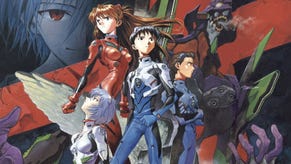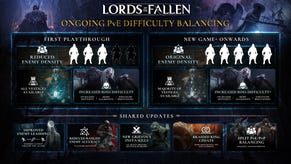Tearaway: how Media Molecule plans to light Vita up
Can Media Molecule rescue Vita with its considerable creative talents? Jack Arnott visits the Guildford studio to see new IP Tearaway, finding something beautiful and unique. There's hope yet.
"Looking around at our titanically messy desks we realised we were building a landscape around us. As concept art got screwed up and thrown on the floor, those paper balls started to take on a life of their own."
Wandering around the Media Molecule studios you're reminded of that curious aphorism about pets looking like their owners – there's something inherently pleasing about the idea of a developer beginning to resemble the games they make.
Imagine it – Treyarch and Infinity Ward's offices replete with crumbling, cratered walls and long, meandering corridors with solitary entry and exit points. Epic Games providing convenient areas of cover for hard-pressed programmers looking to avoid their project manager. One can only begin to imagine how they'd get any work done over at Rockstar.
The truth is a little more prosaic but, in the case of this Guildford-based team, it's hard to ignore the correlation between the nature of their projects and the environment they work in – colourful, playful and bursting with creativity. And, it seems, the process works both ways. The studio's Creative Lead, Rex Crowle believes the inspiration for new IP Tearaway came precisely from this "mad intersection" – where real life bleeds into that of the gaming world.
"Looking around at our titanically messy desks we realised we were building a landscape around us. As concept art got screwed up and thrown on the floor, those paper balls started to take on a life of their own. They could be boulders, or platforms. It's from here that Tearaway was born."
Sony-owned Media Molecule opened its doors to journalists earlier this month to show off a few new features of its forthcoming Vita-only title, of which little has been heard since it was announced at last year's gamescom. Despite the project still being some way off, it looks to be shaping up into a striking offering for Sony's somewhat neglected handheld.
Paper-chase
Of course, you'd expect solid (if a little cutesy for some tastes) platforming fun from the makers of LittleBigPlanet. But it was the innovative streak at the heart of Sackboy's adventures that made LBP such a success. Tearaway follows in the same suit, but where LBP explored the new, connected world of PS3, its little brother is keen to show off all the features of its own system: Sony's Playstation Vita.
For the first time we have a game that really makes the most of the front and back touch screens, uses the gyroscope and integrates the camera and microphone into gameplay. At various points your fingers appear in the game, tearing through its paper fourth-wall to pull switches, open doors and flick enemies away. It's a clever conceit, and challenges the very nature of identity in gaming – when we play Mario we are Mario. But in Tearaway you very much play with your character, Iota. It was notable that the designers and developers I spoke to more than once used the term "buddy movie".
The camera is used at various points to capture real-life images in order to wallpaper different objects and environments, while the microphone allows you to blow on the screen and see the wind you've created affect the environment underneath it. You're offered such a complete tour of everything the Vita can do, in fact, that you can't help but wonder why Tearaway wasn't a launch game. Perhaps this much innovation just couldn't be rushed.
While much has been made of the game's exploration of the Vita's functionality, spend a few minutes in Tearaway's papercraft world and it's the strength of the game's animation and design that really stands out.
It's a cute and cuddly developer tearing up the rulebook with violent abandon. It's a game of exciting contradictions that should light up the Vita just as LBP did the PS3. I only hope that by the time it comes out it won't be too late for the console to provide it with the audience it deserves.
We were shown the island of Sogport, reminiscent of an early 20th Century harbour town, and introduced to one of the game's main enemies – the Wendigo. Drawing on real-life folklore but interpreted through the lens of the game's paper world, the ambling creature – which Iota must escape from or trap as he navigates his way through the game – represents everything that's so impressive about the Tearaway's philosophy and genesis.
Love and affection has gone into every aspect. From the sea-shanty soundtrack to the way the paper grass delicately folds back and forth as you run across it, no stone has been left unturned in an attempt to fully realise a world in which every aspect drums to the same (papery) beat.
The game engine makes use of its own, in-house animation platform which ensures every item in the game could be made from a single sheet of cardboard if so desired. In fact, Media Molecule has offered flatplans on its website of a few of the characters and enemies unveiled so far to allow fans to bring parts of Tearaway into their own world. These flatplans will be unlockable in the game as "real-life trophies" to collect and display proudly to your friends - as Crowle puts it, "playing the game is just the starting point".
Personal message
More detail was also revealed about the game's main quest – your ultimate goal is unlocking a personalised message, individual to each player – and a new playable character was announced, Atoi, a more feminine incarnation of your envelope-headed companion Iota. While finer details remain up in the air, you can be sure that the implementation of these features will be as thoughtful as it is well-executed.
After all this effort to create such a unique gameplay environment, I wondered if there were fears that Tearaway would still simply be remembered as 'that game you put your fingers in' – the fine line between innovation and novelty is a difficult one to tread. Technical director David Smith addressed such concerns.
"Above all we just want to make a good game – nothing's done just for the sake of it. Say you're shouting into the Vita, that's cool to do once or twice but any more than that it would get annoying. When you get to use a new feature you'll be excited – the innovation should always be at the service of everything else.
"Novelty and innovation are an important aspect of making any game. Everything is there for a reason and tied together. I'm actually quite proud that we've axed some innovative features that just didn't fit in with the rest of the game."
It's innovative and fresh, and yet thoroughly traditional and familiar. It's a cute and cuddly developer tearing up the rulebook with violent abandon. It's a game of exciting contradictions that should light up the Vita just as LBP did the PS3. I only hope that by the time it comes out it won't be too late for the console to provide it with the audience it deserves.











